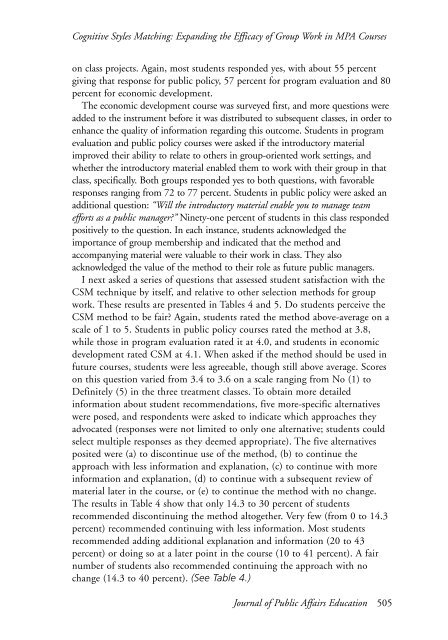JOURNAL OF PUBLIC AFFAIRS EDUCATION - National ...
JOURNAL OF PUBLIC AFFAIRS EDUCATION - National ...
JOURNAL OF PUBLIC AFFAIRS EDUCATION - National ...
Create successful ePaper yourself
Turn your PDF publications into a flip-book with our unique Google optimized e-Paper software.
Cognitive Styles Matching: Expanding the Efficacy of Group Work in MPA Courses<br />
on class projects. Again, most students responded yes, with about 55 percent<br />
giving that response for public policy, 57 percent for program evaluation and 80<br />
percent for economic development.<br />
The economic development course was surveyed first, and more questions were<br />
added to the instrument before it was distributed to subsequent classes, in order to<br />
enhance the quality of information regarding this outcome. Students in program<br />
evaluation and public policy courses were asked if the introductory material<br />
improved their ability to relate to others in group-oriented work settings, and<br />
whether the introductory material enabled them to work with their group in that<br />
class, specifically. Both groups responded yes to both questions, with favorable<br />
responses ranging from 72 to 77 percent. Students in public policy were asked an<br />
additional question: “Will the introductory material enable you to manage team<br />
efforts as a public manager?” Ninety-one percent of students in this class responded<br />
positively to the question. In each instance, students acknowledged the<br />
importance of group membership and indicated that the method and<br />
accompanying material were valuable to their work in class. They also<br />
acknowledged the value of the method to their role as future public managers.<br />
I next asked a series of questions that assessed student satisfaction with the<br />
CSM technique by itself, and relative to other selection methods for group<br />
work. These results are presented in Tables 4 and 5. Do students perceive the<br />
CSM method to be fair? Again, students rated the method above-average on a<br />
scale of 1 to 5. Students in public policy courses rated the method at 3.8,<br />
while those in program evaluation rated it at 4.0, and students in economic<br />
development rated CSM at 4.1. When asked if the method should be used in<br />
future courses, students were less agreeable, though still above average. Scores<br />
on this question varied from 3.4 to 3.6 on a scale ranging from No (1) to<br />
Definitely (5) in the three treatment classes. To obtain more detailed<br />
information about student recommendations, five more-specific alternatives<br />
were posed, and respondents were asked to indicate which approaches they<br />
advocated (responses were not limited to only one alternative; students could<br />
select multiple responses as they deemed appropriate). The five alternatives<br />
posited were (a) to discontinue use of the method, (b) to continue the<br />
approach with less information and explanation, (c) to continue with more<br />
information and explanation, (d) to continue with a subsequent review of<br />
material later in the course, or (e) to continue the method with no change.<br />
The results in Table 4 show that only 14.3 to 30 percent of students<br />
recommended discontinuing the method altogether. Very few (from 0 to 14.3<br />
percent) recommended continuing with less information. Most students<br />
recommended adding additional explanation and information (20 to 43<br />
percent) or doing so at a later point in the course (10 to 41 percent). A fair<br />
number of students also recommended continuing the approach with no<br />
change (14.3 to 40 percent). (See Table 4.)<br />
Journal of Public Affairs Education 505

















